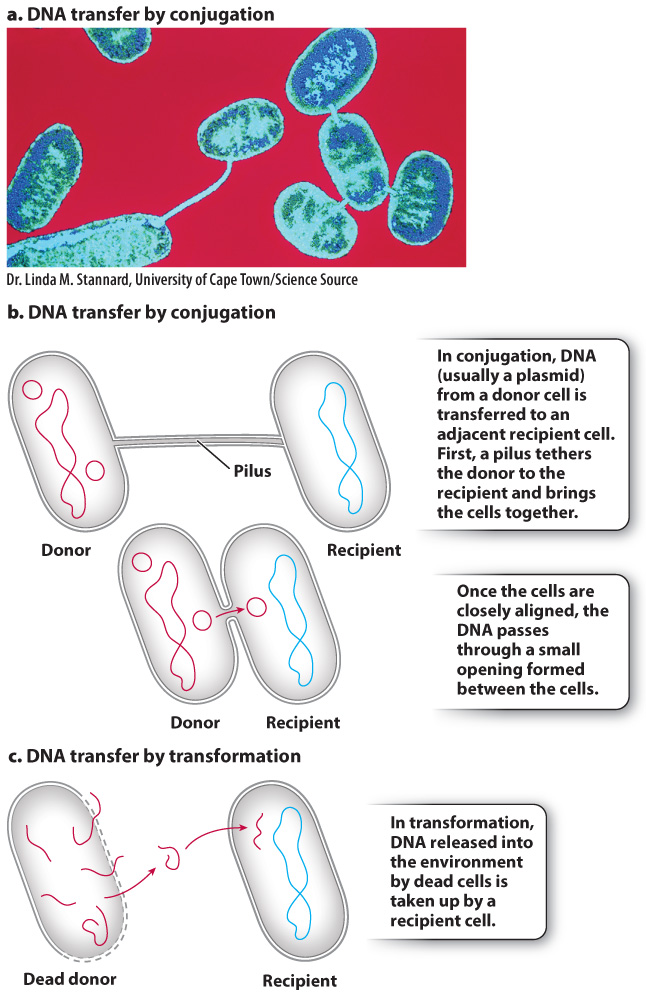Horizontal gene transfer promotes genetic diversity in bacteria.
Bacterial genomes are generally smaller than the genomes of eukaryotes, in part because bacteria lack the large stretches of noncoding DNA characteristic of eukaryotic chromosomes (Chapter 13). The streamlining of the bacterial genome confers certain benefits. For example, bacteria can reproduce rapidly when nutrients required for growth are available in the local environment. Bacteria replicate their DNA from only one or a small number of initiation sites, so genome size can influence rate of reproduction.
Bacteria do not undergo meiotic cell division and cell fusion. That is, they lack the sexual processes characteristic of eukaryotic organisms (Chapters 11 and 42). Despite this, bacterial populations display remarkable genetic diversity. For example, different strains of Pseudomonas aeruginosa, a common disease-
How does this variation arise? In eukaryotic organisms, genes generally pass from parent to offspring. Bacteria also inherit most of their genes from parental cells. However, bacterial cells can also obtain new genes from distant relatives in a process called horizontal gene transfer. This process is a major source of genetic diversity in bacteria.
How does DNA move from one bacterial cell into another independently of cell division? Some bacteria synthesize thin strands of membrane-

Genes can also be transferred from one cell to another without any direct bridge between cells. DNA released to the environment by cell breakdown can be taken up by other cells, a process called transformation (Fig. 26.4b). Transformation was revealed when experiments showed that harmless strains of the bacteria causing pneumonia could be transformed into virulent strains by exposure to media containing dead cells of disease-
Viruses provide a third mechanism of horizontal gene transfer. Recall from Chapter 19 that viruses in bacterial cells sometimes integrate their DNA into the host bacterial DNA. This viral DNA persists within the cells as they grow and divide. Before the virus leaves the cell to infect others, the viral DNA removes itself from the bacterial genome and is packaged in a protein capsule to produce the complete virus particle. This excision is not always precise, and sometimes genetic material from the bacterial host is incorporated into the virus. Viruses released from their host cell go on to infect others, bringing host-
Horizontal gene transfer allows bacterial cells to gain beneficial genes from organisms distributed throughout the bacterial domain and beyond. Indeed, bacteria everywhere are constantly reshaping their genomes. Bacteria, therefore, are not the poor cousins of eukaryotes, unable to generate genetic diversity by sexual recombination. Instead, bacteria have highly efficient mechanisms for adding and subtracting genes that permit them to evolve and adapt rapidly to local conditions. Perhaps the most widely discussed and worrisome manifestation of horizontal gene transfer is the rapid spread of antibiotic resistance among bacteria (Chapter 49).
Quick Check 1 In eukaryotes, sexual reproduction is the main process by which new gene combinations are generated. How do bacteria generate new gene combinations in the absence of sexual reproduction?
Quick Check 1 Answer
In prokaryotic organisms, genes are transferred from one organism to another by horizontal gene transfer, facilitating the generation of new gene combinations.